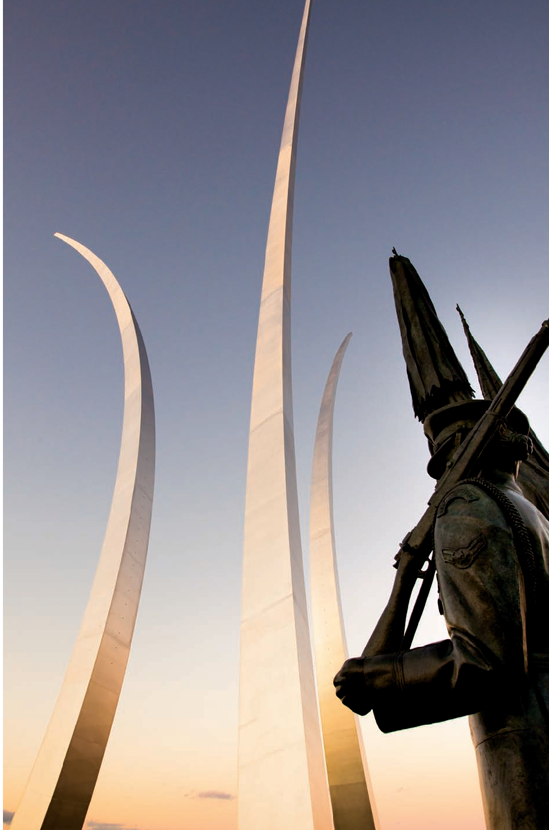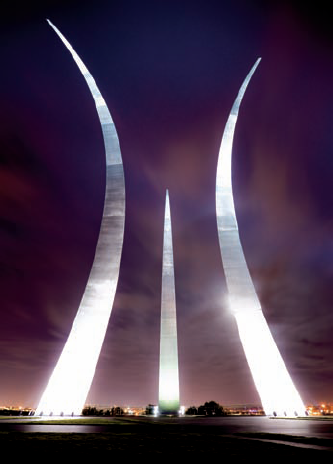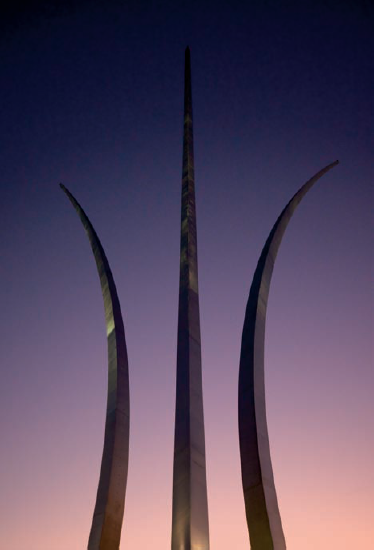
The entrance of the United States Air Force Memorial in the evening. Taken at ISO 500, f/5, 1/100 second with a 20mm lens.
The United States Air Force Memorial honors the service and sacrifices of the men and women of the U.S. Air Force and the organizations related to it.
The newest of the major memorials in the Washington, D.C. area (it was dedicated in 2006), it is also one of the most dynamic and contemporary. The 270-foot tall stainless steel structure evokes the Air Force Thunderbird's contrails as they perform their bomb-burst maneuver, and the three arcs represent the three core values of the Air Force — integrity first, service before self, and excellence in all that is done. They are also meant to represent the three branches of the Air Force: active, guard, and reserve.
Because of the minimal design of this memorial, the best pictures often come from within the memorial's walkway and the road next to it.

Figure 20.1. The best locations from which to photograph the United States Air Force Memorial: (A) facing east from the memorial, (B) at the memorial's base, and (C) S. Columbia Pike. Nearby photo ops: (2) Arlington National Cemetery, (8) Mount Vernon Estate (13 miles south), and (15) Pentagon Memorial.
If you stand on the first set of steps to your left after you enter the memorial from its main entrance, you see an unobstructed view of the stainless steel arcs, and there is enough space to capture their vast 270-foot height in the frame (see Figure 20.1). It's a lovely place from which to view the arcs, and you will get a bit of a glow from Washington, D.C. in the background.
A more unconventional but definitely interesting way to photograph the arcs is to view them from directly underneath (see Figure 20.2). You can compose a shot a number of ways here.
Another location from which you can photograph the memorial is along S. Columbia Pike, the road that winds its way along the south and east sides of the memorial. On the east side of the memorial along S. Columbia Pike, you can photograph it from this vantage point (see Figure 20.3).
The Air Force Memorial is fun to photograph, and you can create colorful, vibrant images of it by using a variety of methods.
Bringing the correct gear enables you to create a variety of interesting compositions.
For the shot looking east (refer to Figure 20.1), wide lenses on the order of 16- 20mm are necessary, but it's always possible to get around this by cropping off the bottom of the memorial. Wide lenses are the rule for the images from within the memorial itself (refer to Figure 20.2), although like any rule there are exceptions. The advantage of shooting from S. Columbia Pike (refer to Figure 20.3) is that you can photograph the entire memorial by using a common 35mm focal length.
For daytime images, try a polarizing filter to enhance the contrast between clouds and the sky, or to just darken an already blue sky.
Long-exposure night shots are great to get here, but the same compositions can be done during conditions with more light by handholding your camera.
If you are handholding, you want to focus on foreground elements in the photo and use a larger aperture value, such as f/11, to get the bulk of the monument in focus; if you focus on the far elements, the foreground portions of your photo may not be in focus, which is distracting. Using your Aperture Priority mode is a good option here, so you have some direct control. Finally, use your exposure compensation feature to fine-tune the exposure so that the sky and the memorial are well exposed.
As for white balance, during the day you will most likely want to use your Daylight setting because a large part of your image will be the sky. At night, the Daylight setting works well too, because the lights on the memorial are a similar color to daylight, so you can start there and change it to see how it affects your image.
The Air Force Memorial is a beautiful structure that is the subject of thousands of beautiful photographs. Time, weather, and creativity will all be up to your interpretation in creating a unique image.
As I stated previously concerning white balance, there is an abundant sky shown in most photos of the Air Force Memorial, so shooting while the sky is interesting is key here. Sunrise and sunset are both great photographic opportunities, and the memorial also will have fewer visitors.
Because the memorial is relatively new, there are still lots of pictures out there that have yet to be shot of it. Uncommon weather would help to create a unique photo here. If the weather is foggy, remember to increase your exposure to deal with the brightness of the fog (the same goes for bright, snowy conditions).
Night is a great time to shoot here, and the memorial is open late enough that there are plenty of opportunities to do so. The memorial is open every day of the year with hours from 8 a.m. to 11 p.m. from April 1 through September 30, and 8 a.m. to 9 p.m. from October 1 through March 31.
For night photography, use a tripod and long shutter speeds as a different way to shoot and to get very creative results. Long shutter speeds will blur out passing clouds above while allowing you to use a lower ISO for the best image quality. A tripod also lets you carefully compose your image as well.
The first thing to do is to figure out the right exposure. The simplest way to do this will be to use your camera's Night mode, but this will have different results based on how your camera chooses to interpret the scene. If you are using an automatic exposure mode, select Aperture Priority and set a higher aperture such as f/11 or f/16. This will force your camera to use a long shutter speed. Your camera has a maximum shutter speed, however, so keep this in mind as you are dialing in settings — you may have to raise your ISO to keep at or below its maximum shutter speed setting. Set your camera on its self-timer mode to let it start the exposure without any movement.
If your camera has a Bulb setting, this will let you use a cable release to keep the shutter open for any amount of time you wish to properly expose the scene. For example, if you find a good exposure at f/5.6, 30 seconds at ISO 400 using Aperture Priority, you could increase the exposure to f/11, 2 minutes at ISO 400 and get quite a different effect with the clouds and light surrounding the memorial. Depending on the type of camera you have, you can use much longer exposures as well.
Besides the ways I describe in this chapter, you also don't necessarily have to show each entire arc in your photo. Experiment with compositions that exclude only one or two arcs rather than all three — showing only one or two complete arcs can be enough to interpret the scene in a more creative way. Additionally, you can use the bronze Honor Guard statues in the foreground to compose a photo.




